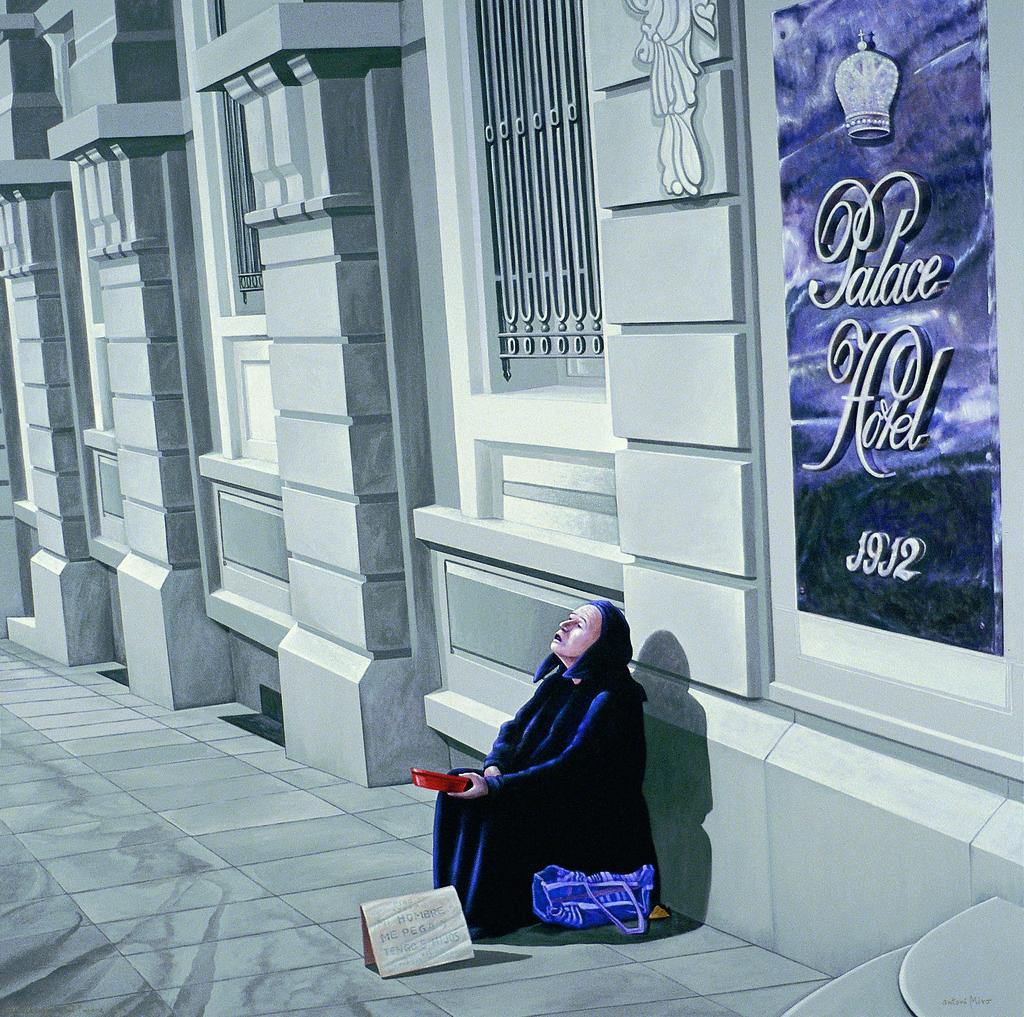Pidolaire al palace (A beggar at the palace)
The year 2004 will be remembered for the shocking terrorist attacks in Madrid. This work though touches on other kinds of horror. It was an election year in which the party in power changed. Although there were some critical voices, the economic crisis then looming still lay a few years off. “Spain is doing great”, was yet the continually repeated message. That message was clearly at odds with what the artist depicts in this painting.
Furthermore, there were no signs of change in the medium term. The formidable economic indicators (ever-rising economic growth, ever lower unemployment and shrinking indebtedness) that had characterised the two previous legislatures under the (Conservative) PP government would linger on for most of the first legislature under a (Socialist) PSOE government. With hindsight, we know that this economic boom in both average and aggregate terms was based on privatisation, on a runaway real estate sector boom, and on the synergies this sector established with the financial and construction sectors.
During the election campaign, the Partido Popular [Spain’s Conservative Party] insisted that “Together we can go even further”, as if the boom was the direct result of government policies and could go on forever. The Socialist slogan was “We deserve a better Spain.” The two slogans reflected different takes on the situation but both parties were complacent about the booming economy, though to a different extent. The main points of disagreement lay in how they saw inequality in the country and their different stances on Spain’s participation in the Iraq War.
This picture shows a stark contrast between opulence and desolation. It reveals that the overall positive consideration of a group does not exempt from the existence of unsustainable individual conditions, which find themselves neutralised by the more comfortable ones. The hotel façade is that of Madrid’s The Palace, an establishment that, together with The Ritz, traditionally epitomises opulence. Outside, a woman desperately begs for help. A hand-written sign lists her woes: gender violence, exploitation... poverty, in a nutshell.
As one can see, this evidence of a particular reality, which was not that uncommon then, serves as a bleak harbinger of the extension this problem would reach later on. A woman begs, as many were doing then. Yet there were many fewer beggars in 2004 than just five or ten years later.
The background is fairly homogeneous, with little variation, being painted in a narrow range of greys, creating a fairly neutral backdrop. The letters etched on the funerary marble are rendered in silver although in real life they are gilded. The artist’s choice of silver is to avoid them being too visually accentuated, as happens in real life. The figure and her attributes, together with the alluded memorial gravestone, are positioned on this background slanted to the right, tensely drawing the viewer’s gaze to the bottom third of the picture.
The beggar is dressed in black, with a red begging-bowl, a purplish hold-all and a light-brown cardboard sign that seems to replace the yellow that would complete the tricolour flag of the Spanish Second Republic (1931-1939) — an ironic hint at another kind of opposition. The begging-bowl occupies a central place in the composition and its colour makes it stand out from the rest of the picture. It is what draws the viewer’s eye to the written message. The chances of anyone heeding her seem remote, for no shadows from passers-by are to be seen on the pavement, despite the fact that the woman raises her face to the sky, somehow screaming, but a silent scream this time, in a way that recalls the painful gesture of Julio González’s La Montserrat.
Santiago Pastor Vila
